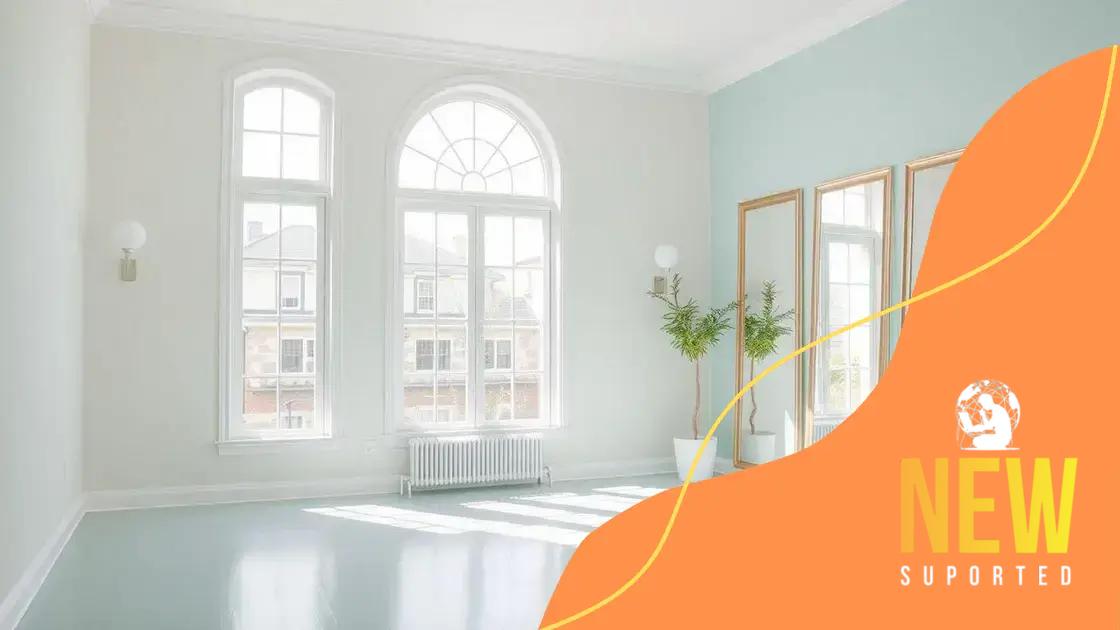How to maximize small space living with home design

To maximize small space living with home design, use multifunctional furniture, smart storage solutions, and effective color and lighting choices to create a personalized and inviting atmosphere.
How to maximize small space living with home design can transform even the coziest of spaces into stylish and functional homes. Ever wondered how clever design choices can make a difference? Let’s explore!
Choosing multifunctional furniture
When it comes to small spaces, choosing multifunctional furniture is key to maximizing your living area. These pieces not only save space but also add character to your home.
Importance of Multifunctional Furniture
In a small space, every inch counts. By selecting furniture that serves multiple purposes, you can create a more flexible environment. For example, a sofa bed allows you to have a stylish couch during the day and a comfortable bed at night.
Popular Multifunctional Furniture Options
- Storage ottomans: These can serve as seating, a footrest, or storage space for blankets and other items.
- Murphy beds: Great for small bedrooms, they fold up when not in use, freeing up floor space.
- Coffee tables with storage: Look for tables that open up to reveal hidden compartments for magazines and remotes.
- Extendable dining tables: Perfect for tiny kitchens, they can be expanded when guests come over.
A key point is to visualize how each piece will fit into your space. You might also want to consider the style and color of your multifunctional furniture. Lighter colors can make a room feel larger, while darker shades may create a cozy atmosphere.
Tips for Selecting Multifunctional Pieces
When choosing multifunctional furniture, keep a few tips in mind. First, measure your space accurately. This ensures that the furniture you select will fit comfortably. Second, think about your lifestyle. If you entertain often, opt for furniture that can easily transition from day to night.
Keep in mind that furniture with built-in storage is a game-changer. Avoid clutter by choosing pieces that offer a place to store items out of sight. Lastly, remember to invest in quality pieces. While multifunctional furniture can be practical, it should also be durable and stylish.
Smart storage solutions for tiny homes
Implementing smart storage solutions is crucial for maximizing space in tiny homes. Creative storage ideas can help keep your living area organized and efficient.
Innovative Storage Ideas
One effective way to create storage is by using vertical space. Installing shelves above doors or cabinets can provide extra room without taking up floor space. Think about under-bed storage for seasonal items or even everyday essentials.
Multi-Purpose Furniture for Storage
- Beds with drawers: Opt for beds that come with built-in drawers, perfect for keeping clothes or linens out of sight.
- Wall-mounted shelves: These not only display decor but can also hold books, plants, or other essentials.
- Foldable furniture: Consider tables and chairs that can be folded away when not in use, freeing up space.
- Storage benches: Ideal for entryways, these can hold shoes and bags while providing a seat.
Each of these solutions can help you maintain a clutter-free environment. Additionally, using baskets and bins can further organize your items. Labeling these containers makes it easy to find what you need without digging through piles.
Maximizing Closet Space
Don’t overlook the potential of your closets. Adding extra shelves or hanging organizers can turn a standard closet into a smart storage area. This keeps clothes visible and accessible, reducing time spent searching for items. Another tip is to use slim hangers to save space while keeping your wardrobe neat.
Smart storage solutions are about finding ways to maximize every inch of your home. Remember that creativity is key. Whether it’s utilizing nooks and crannies or choosing the right furniture, each decision can contribute to a more functional tiny home.
Using color and light to create spaciousness

Using color and light effectively can greatly influence how spacious your small home feels. The right choices can open up your space and create an inviting atmosphere.
The Power of Color
Choosing lighter hues for your walls can make a room appear larger. Soft whites, pastels, and light grays reflect light well and create an airy feel. Dark colors, on the other hand, can make a space feel cozy but may also close it in.
Accent Walls
If you love bold colors, consider using them on an accent wall. This adds personality without overwhelming the space. Pair a bright wall with neutral furniture to keep the room balanced.
- Soft blues and greens: These shades evoke tranquility and can make rooms feel relaxed.
- Earthy tones: Beiges and soft browns can ground a space while still keeping it open.
- Bright yellows or oranges: These colors inject energy but should be used sparingly, as accents.
In addition to color, natural light plays a significant role in how we perceive space. Maximizing natural light by keeping windows unobstructed can help make any tiny room feel more extensive and open.
Choosing Lighting Fixtures
Layering your lighting is essential. Use a mix of ambient, task, and accent lighting to create depth. Recessed lighting can brighten a room without taking up space, while floor lamps can add height and dimension.
Mirrors are another clever trick. Placing mirrors opposite windows can reflect light and create the illusion of more space. You can also choose furniture with glass or reflective surfaces to enhance this effect.
Remember, the goal is to create a harmonious atmosphere that feels spacious. Combining colors and light smartly can transform your small home into a bright and welcoming sanctuary.
Designing with vertical space in mind
Designing with vertical space in mind is essential for small living areas. Utilizing the height of your home can help maximize storage and create a more open feel.
Vertical Shelving Solutions
One effective way to utilize vertical space is by installing tall bookshelves or wall-mounted shelves. These can draw the eye upward and create an illusion of more space. They are perfect for showcasing decor items or storing books and plants.
High Storage Cabinets
Consider using tall cabinets to take advantage of vertical storage. This not only keeps your items organized but also frees up floor space, making the room look less cluttered.
- Corner shelves: These are perfect for making use of often-neglected corners, providing additional storage while creating visual interest.
- Hanging planters: They add greenery without taking up surface area, making any space feel fresh.
- Over-the-door storage: Use the back of doors to add more storage for shoes, bags, or accessories.
In addition to shelving and cabinets, think about how you can incorporate other vertical elements like mirrors. Placing tall mirrors on walls reflects light and creates a sense of depth, further enhancing the feeling of spaciousness.
Utilizing Furniture Height
Choosing furniture that is higher off the ground can also help. For instance, sofas or tables with slender legs give a more airy feel to the room. Arranging your furniture to allow for easy flow can make a small area feel less cramped.
Another important aspect of designing with vertical space is the use of vertical patterns. Stripes on walls or ceilings can draw the eye upward and make the room feel taller. Keep these designs subtle so they do not overwhelm the space.
Personalizing your small living area
Personalizing your small living area is a fantastic way to make your space feel like home. Even in limited areas, you can express your style through creative design choices.
Choosing the Right Decor
Start by selecting decorative pieces that reflect your personality. Use artwork, photographs, or unique wall hangings to add character. Incorporating elements from your travels or family memories can create a warm and inviting atmosphere.
Mixing Textures and Patterns
Mixing different textures and patterns can make your space dynamic. Adding throw pillows, blankets, and rugs in various fabrics can create depth. Focus on layering textures to create a cozy environment.
- Bold patterns: Use these for cushions or a statement chair to draw attention.
- Soft textiles: Choose soft, inviting fabrics for your sofa and bedding to enhance comfort.
- Natural elements: Incorporate wood, plants, and metals for a balanced and collected look.
Lighting is another important element in personalizing your living area. Use floor lamps, table lamps, and string lights to create ambiance. Layering your lighting will not only illuminate the room but also add to its charm.
Displaying Personal Items
Displaying personal items, such as books or artisanal crafts, can add a unique touch. Create a small gallery wall with your favorite photos or art that tells your story. Floating shelves are great for showcasing these items without taking up valuable floor space.
Color can play a significant role as well. Choose a color palette that resonates with you. Whether you prefer calming neutrals or vibrant hues, applying a cohesive color scheme can unify your small space.
Lastly, don’t shy away from DIY projects. Creating custom decor or refurbishing old furniture can be a fun way to add individuality. Personal touches, no matter how small, can make your space truly feel like your own.
In conclusion, personalizing your small living area is a fun and rewarding way to make it feel like home. By using smart design choices, you can create a cozy, inviting space that reflects your unique style. Remember to focus on layering textures, using color effectively, and incorporating personal items that tell your story. With these tips, your small space can be both functional and beautiful.
FAQ – Frequently Asked Questions about Personalizing Your Small Living Area
What are some easy ways to personalize my small space?
You can personalize your small space by incorporating artwork, using decorative pillows, and showcasing personal items that represent your style.
How can color choice affect the feel of my living area?
Choosing lighter colors can make your space feel larger and more open, while darker colors can create a cozy atmosphere.
What role does lighting play in personalizing a small space?
Lighting creates ambiance and highlights your decor. Layering different lighting sources can enhance the overall feel of your living area.
How do I mix textures effectively in a small space?
Combine throw pillows, rugs, and blankets in various fabrics to create depth and visual interest without overwhelming the room.






